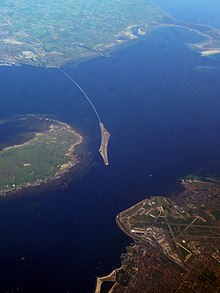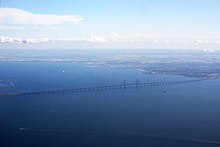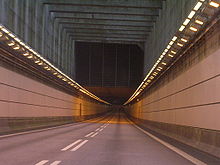(peberholm-artificial island)
The Öresund or Øresund Bridge is a double-track railway and dual carriageway bridge-tunnel across the Øresund strait between Scania (southernmostSweden) and Denmark.
The bridge runs nearly 8 kilometres (5 miles) from the Swedish coast to the artificial island ofPeberholm, which lies in the middle of the strait. The remainder of the link is by a 4 km (2.5 miles) tunnel from Peberholm to the Danish island of Amager. The Øresund Bridge is the longest combined road and rail bridge in Europe, and connects two major metropolitan areas: Copenhagen, the Danish capital city, and the major Swedish city of Malmö. It connects the road and rail networks of Scandinaviawith those of Central and Western Europe. A data cable also uses the bridge to carry all Internet data transmission for Finland.
The international European route E20 crosses via the road, the Oresund Line via the railway. The construction of the Great Belt Fixed Link, connectingZealand to Funen and thence to the Jutland Peninsula, and the Øresund Bridge have connected Central and Western Europe to Scandinavia by road and rail. The Øresund Bridge was designed by the Danish engineering firm COWI.
The justification for the additional expenditure and complexity related to digging a tunnel for part of the way, rather than raising that section of the bridge, was to avoid interfering with air traffic from the nearby Copenhagen International Airport, to provide a clear channel for ships in good weather or bad, and to prevent ice floes from blocking the strait. The Øresund Bridge crosses the border between Denmark and Sweden, but in accordance with the Schengen Agreementand the Nordic Passport Union, there are usually no passport inspections. There are random customs checks at the entrance toll booths entering Sweden, but not when entering Denmark.
The Øresund Bridge received the 2002 IABSE Outstanding Structure Award.
| Øresund Bridge Öresund Bridge | |
|---|---|
 | |
| Official name | Øresundsbroen, Öresundsbron |
| Carries | Four lanes of European route E20 Double-track Oresund Railway Line |
| Crosses | Oresund strait (The Sound) |
| Locale | Copenhagen, Denmark, and Malmö, Scania, Sweden |
| Designer | Klaus Falbe Hansen, Jorgen Nissen, Niels Gimsing, Georg Rotne |
| Engineering design | Ove Arup & Partners Setec ISC Gimsing & Madsen |
| Design | Cable-stayed bridge |
| Total length | 7,845 metres (25,738 ft) |
| Width | 23.5 metres (77.1 ft) |
| Longest span | 490 metres (1,608 ft) |
| Clearance below | 57 metres (187 ft) |
| Constructed by | Hochtief, Skanska, Højgaard & Schultz andMonberg & Thorsen |
| Opened | 1 July 2000 |
In Denmark and Sweden, the bridge is usually referred to as Øresundsbroen and Öresundsbron respectively. The bridge company insists on Øresundsbron, a compromise between the two languages. Since the crossing is composed of a bridge, an artificial island and a tunnel, it is sometimes called the "Öresund Link" or the "Öresund Connection" (Danish: Øresundsforbindelsen, Swedish: Öresundsförbindelsen).
History
The construction of the Øresund Bridge, which was undertaken by a joint venture of Hochtief, Skanska, Højgaard & Schultz and Monberg & Thorsen, began in 1995, and was finished 14 August 1999. Crown Prince Frederikof Denmark and Crown Princess Victoria of Sweden met midway across the bridge-tunnel on 14 August 1999 to celebrate its completion. Its official dedication took place on 1 July 2000, with Queen Margrethe II, and King Carl XVI Gustaf as the host and hostess of the ceremony. The bridge-tunnel was opened for public traffic later that day. On 12 June 2000, two weeks before the dedication, 79,871 runners competed in Broloppet, a half marathon from Amager, Denmark, to Skåne, Sweden.
In spite of two schedule setbacks – the discovery of 16 unexploded World War II bombs on the seafloor and an inadvertently skewed tunnel segment – the bridge-tunnel was finished three months ahead of schedule.
Although traffic jumped 61 percent in the first years, the crossing was not used as much as expected (probably because of the high tolls) but since 2005 there has been a rapid increase in traffic. This may have been caused by Danes buying homes in Sweden to take advantage of lower housing prices in Malmö and commuting to work in Denmark. In 2012, to cross by car cost DKK 310, SEK 375 or € 43, with discounts of up to 75% available to regular users. In 2007, almost 25 million people travelled over the Øresund Bridge: 15.2 million by car and bus and 9.6 million by train. By 2009, the figure had risen to 35.6 million by car, coach or train.
Link features
The bridge
At 7,845 m (25,738 ft), the bridge covers half the distance between Sweden and the Danish island of Amager, the border between the two countries being 5.3 km (3.3 mi) from the Swedish end. The structure has a mass of 82,000 tonnes and supports two railway tracks beneath four road lanes in a horizontal girder extending along the entire length of the bridge. On both approaches to the three cable-stayed bridge sections, the girder is supported every 140 m (459 ft) by concrete piers. The two pairs of free-standing cable-supporting towers are 204 m (669 ft) high allowing shipping 57 m (187 ft) of head room under the main span, but most ships' captains prefer to pass through the unobstructed Drogden Strait above the Drogden Tunnel. The 491 m (1,611 ft) cable-stayed main span is possibly the longest of this type in the world. A girder and cable-stayed design was chosen to provide the specific rigidity necessary to carry heavy rail traffic, and also to resist large accumulations of ice.
The bridge may experience short-term closures during rare massive storms as a safety precaution against hurricane-force winds or ice falling off the cables; it closed for several hours, for example, during the St Jude storm in October 2013.
Due to high longitudinal and transverse loads acting over the bridge and to accommodate movements between the superstructure and substructure, it has bearings weighing up to 20t each, capable of bearing vertical loads up to 96,000 kN in a longitudinal direction and up to 40,000 kN in transverse direction. The design, manufacturing and installation of the bearings were carried out by the Swiss civil engineering firm Mageba.
Peberholm
The bridge joins Drogden tunnel on the artificial island of Peberholm (pepper islet). The Danes chose the name to complement the natural island of Saltholm (salt islet) just to the north. Peberholm is a designated nature reserve built from Swedish rock and the soil dredged up during the bridge and tunnel construction, approximately 4 km (2.5 mi) long with an average width of 500 m (1,640 ft). It is 65 ft (20 m) high.
Drogden Tunnel
The connection between Peberholm and the artificial peninsula at Kastrup on Amager island, the nearest populated part of Denmark, is through the 4,050 m (13,287 ft) long Drogden Tunnel (Drogdentunnelen). It comprises a 3,510 m (11,516 ft) undersea tube tunnel plus 270 m (886 ft) entry tunnels at each end. The tube tunnel is made from 20 prefabricated reinforced concrete segments – the most massive in the world at 55,000 t each – interconnected in a trench dug in the seabed. Two tubes in the tunnel carry railway tracks, two carry roads and a small fifth tube is provided for emergencies. The tubes are arranged side by side.
Rail transport
The rail link is operated jointly by the Swedish SJ and Danish railways via DSBFirst on a commission by Skånetrafiken and other county traffic companies (that also sell tickets) and the Danish transport agency. A series of new dual-voltage trains was developed, linking the Copenhagen area with Malmö and southern Sweden as far as Gothenburg and Kalmar. SJ operates X2000and InterCity trains over the bridge, with connections to Gothenburg and Stockholm. DSB operates trains to Ystad that connect directly to a ferry to Bornholm. Copenhagen Airport atKastrup has its own railway station close to the western bridgehead. Trains operate every 20 minutes, once an hour during the night, in both directions. An additional couple of Øresundstrains are operated at rush hour, and 1–2 SJ trains and DSB trains per hour and direction every other hour. Freight trains also use the crossing.
The rail section is double track standard gauge (1435 mm; 4 ft 81⁄2 in) and capable of speeds of up to 200 kilometres per hour (120 mph), slower in Denmark, especially in the tunnel section. There were challenges related to the difference in electrificationand signalling between the Danish and Swedish railway networks. The solution chosen is to switch the electrical system from Swedish 15 kV, 16.7 Hz to Danish 25 kV, 50 Hzbefore the eastern bridgehead at Lernacken in Sweden. The line is signalled according to the standard Swedish system across the length of the bridge. On Peberholm the line switches to Danish signalling, which continues into the tunnel.
Swedish trains run on the left, Danish on the right. Initially the switch was made at Malmö Central Station, a terminus at that time. After the 2010 inauguration of the Malmö City Tunnel connection, a flyover was built atBurlöv, north of Malmö, where the two southbound tracks cross over the northbound pair. The railway in Malmö thus uses the Danish standard.
Costs
The cost for the Oresund Connection, including motorway and railway connections on land, was DKK 30.1 billion (~US$5.7bn) according to the 2000 year price index, with the cost of the bridge paid back by 2035. In 2006 Sweden began spending a further SEK 9.45 billion on the Malmö City Tunnel as a new rail connection to the bridge. It was completed in December 2010.
The connection will be entirely user-financed. The owner company is owned half by the Danish government and half by the Swedish government. This owner company has taken loans guaranteed by the governments to finance the connection, and the user fees are the only income for the company. After the increase in traffic, these fees are enough to pay the interest and begin paying back the loans, which is expected to take about 30 years.
Taxpayers have not paid for the bridge and the tunnel, but tax money has been used for the land connections. Especially on the Danish side, the land connection has domestic benefit, mainly connecting the airport to the railway network. The Malmö City Tunnel has the benefit of connecting the southern part of the inner city to the rail network and allowing many more trains to and from Malmö.
Toll charge
As of 1 January 2014 the tolls for one-way trip without discount (including VAT at 25%) in Danish kroner (DKK),Swedish kronor (SEK) and euro (EUR) were priced at:
| Vehicle | DKK | SEK | EUR |
|---|---|---|---|
| Train ticket | 86 | 105 | 11 |
| Motorbike | 175 | 205 | 24 |
| Standard car | 335 | 390 | 46 |
| Minibus (6–9 metres) | 670 | 780 | 92 |
| Motorhome/car+caravan | 670 | 780 | 92 |
| Lorry/truck (9–20 metres) | 920 | 1080 | 126 |
| Bus (≥9 metres) | 1280 | 1500 | 175 |
| Lorry/truck (≥20 metres) | 1380 | 1620 | 189 |










